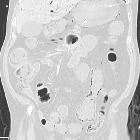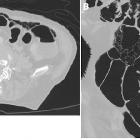Pneumatosis coli











Pneumatosis coli is a descriptive sign presenting radiographically as intramural gas limited to the colonic wall.
Terminology
There are different terminologies in the medical literature, such as pneumatosis intestinalis, pneumatosis coli, and pneumatosis cystoides intestinalis. Pneumatosis intestinalis is used when only the small bowel wall is involved. Pneumatosis cystoides intestinalis (or coli) is descriptive for multiple gaseous cysts along the bowel wall.
Pathology
In the pediatric population, it is most frequently seen in premature infants . Although symptoms are relatively mild, they are the same as those seen in early (stage I) necrotizing enterocolitis.
In adults, it can have both benign and life-threatening causes.
Benign pneumatosis can be caused by a variety of reasons such as pulmonary disease, systemic disease (scleroderma, lupus, AIDS), intestinal inflammation, iatrogenic/procedures, medications, and organ transplation .
Life-threatening pneumatosis can be caused by intestinal ischemia, obstruction, enteritis/colitis, toxic caustic ingestion, toxic megacolon, organ transplantation, and collagen vascular disease .
Radiographic features
The following are imaging features of clinically worrisome pneumatosis :
- soft tissue bowel wall thickening
- free intraperitoneal fluid
- lesser extent of pneumatosis (more extensive pneumatosis is more commonly benign)
- periintestinal soft-tissue stranding
- abnormal bowel wall enhancement
- atherosclerosis and vascular occlusion
Pneumoperitoneum and pneumoretroperitoneum can be seen with both idiopathic and ischemic pneumatosis .
Differential diagnosis
Pseudopneumatosis (mimics) include:
- gas trapped between bowel wall and luminal contents
- gas trapped by opposing mucosal folds
- gas bubbles adherent to the bowel wall
Siehe auch:

 Assoziationen und Differentialdiagnosen zu Pneumatosis coli:
Assoziationen und Differentialdiagnosen zu Pneumatosis coli:





